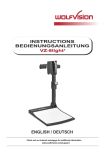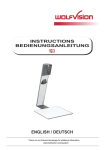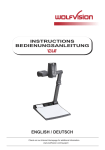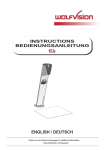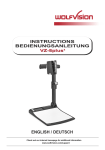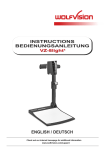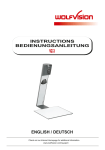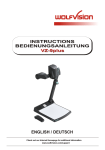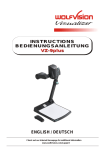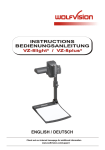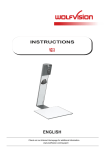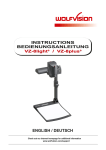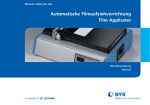Download Manual VZ8light_4 English_Deutsch_mit AutoExposure.cdr
Transcript
R INSTRUCTIONS BEDIENUNGSANLEITUNG VZ-8light4 ENGLISH / DEUTSCH Check out our internet homepage for additional information www.wolfvision.com/support ENGLISH Precautions WARNING! Risk of electric shock Dangerous voltage inside Please observe the following: Use this Visualizer only with the correct voltage as shown on the type label ! Do not expose the Visualizer to heat or moisture ! Protect the Visualizer from excessive shocks ! Make sure that sufficient air circulation for cooling the Visualizer is possible (ventilation slots on the lamp housing)! If there is any abnormality (abnormal noise, smell, smoke etc.) disconnect the Visualizer from mains immediately and contact your Visualizer dealer! Do not use a damaged power supply / power cord. This may cause short circuits or electrical shocks! To prevent danger, do not modify the Visualizer or operate without the cover panel firmly in place! Do not expose the Visualizer to water, metallic objects or any flammable material. Avoid installing the Visualizer in locations exposed to strong magnetic fields or electrical currents. Avoid installing the Visualizer in environments where there is radiation. This could cause monitor image distortion or damage the image sensor of the camera. Do not pull the plug from the power socket with wet hands! If the Visualizer is not used for a long time, disconnect it from mains! The external power supply has to be approved by CSA or UL in accordance to CSA 22.2-60950 or UL 1950. The outputs have to be LPS (limited power source) rated! Precautions for LED light according EN62471: LED lightning system - Do not stare into beam! Do not modify the LED lightning system! Do not view the light beam with optical instruments! Ne pas regarder dans l'objectif lorsque le visualiseur est en marche! 1 Approval Marks on the unit: C Tested to complywith FCC standards for home or office use US L I ST E D 9902476 FCC information: This device complies with part 15 of the FCC rules. Operation is subject to the following two conditions: (1) this device may not cause harmful interference, and (2) this device must accept any interference received, including interference that may cause undesired operation. Note: This equipment has been tested and found to comply with the limits for a class B digital device, pursuant to part 15 of the FCC rules. Information to user: The user manual or instruction manual for an intentional or unintentional radiator shall caution the user that changes or modifications not expressly approved by the party responsible for compliance could void the user's authority to operate the equipment. This product is built according to Directive EMC and to Directive electrical equipment. Inspections, tests and evaluation are according to UL 60950. CSA 22.22-60950 Inspections, tests and evaluation are according to the CB-Scheme Inspections, tests and evaluation are according to the PCT-Scheme Worldwide Patents US 7,035,011 KR 0576806 RU 2265284 TW I 226969 and others Copyright Information Copyright © by WolfVision. All rights reserved. WolfVision, Wofu Vision and are registered trademarks of WolfVision Holding AG, Austria. No part of this document may be copied, reproduced, or transmitted by any means, without prior written permission from WolfVision. Except documentation kept by the purchaser for backup purposes. In the interest of continuing product improvement, WolfVision reserves the right to change product specifications without notice. Information in this document may change without notice. Disclaimer: WolfVision shall not be liable for technical or editorial errors or omissions. The units are "MADE IN EU/AUSTRIA” Printed in Austria, October 2012 2 Components of the Visualizer #9 #10 #8 #7 #6 #11 #5 #4 #3 4 lus VZ-8p #2 Visualizer #1 #1 #2 #3 #4 #6 #7 #8 #9 #10 #11 Alternative anti-theft security (found underneath the unit as shown on page 17) Working surface (see page 6) LIGHT key (see page 5) POWER key and Power indication LED (see page 5) Connectors (on the back of the unit as shown on next page) Close up lens for camera (see page 7) Light source Zoom wheel (see page 5) Camera keys (see page 5) Pull pad to lift the arm up/down (see page 6) 3 Connectors (#5) #12 #14 #13 #12 #13 #14 #15 #16 #17 #18 #19 #18 #16 #15 #17 ® Slot for Kensington lock (see page 17) HDMI OUTput (see page 12) RGB OUTput (15pin) (see page 12) HDMI INput for external HDMI-signals (see page 13) USB port to Client (for firmware update only) (see page 16) USB port to Host (to computer) (see page 10) Power connection 12V DC LAN port 10/100 Tbase with PoE+ functionallity (see page 11) 4 #19 Keys on the Visualizer One of the great features of WolfVision's Portable Desktop Visualizers is that only the most necessary keys are on the unit itself. Therefore anyone can use it without instructions. Base #3 #4 #3 LIGHT key Switches the top light on and off. The LIGHT key also works as a ONE PUSH WHITE BALANCE key if pressed for 2 seconds (see page 9). WHITE #4 POWER key Switches the unit on and off. When switching the unit on the Visualizer automatically runs power-on preset. Camera Head Standard mode #9 #20 FREEZE #9 ZOOM WHEEL Turn the wheel down to zoom in (TELE), and up to zoom out (WIDE). The more you turn the ZOOM WHEEL, the faster the zooming works. Using the ZOOM keys (wheel) also switches auto iris on again. PRESET FOCUS- FOCUS+ #21 #22 #22 AF EXTERN #23 #24 MENU Menu mode #9 #20 #21 #22 #22 #23 ? #24 MENU #20 PRESET key / menu: select key - right For storing the preset, press the PRESET key for more than 2 seconds. For recalling the preset, press the PRESET key quickly (see page 8). When on-screen menu is activated, it works as select key (see page 14). #21 FREEZE key / menu: select key - left Freezes the current image. The FREEZE light indicates if the FREEZE-mode is activated. When on-screen menu is activated, it works as select key (see page 14). #22 Manual FOCUS keys / menu: navigation key - up and down When the Manual FOCUS keys are pressed the Visualizer switches off the autofocus function. Using the AF-key switches the autofocus function on again (see page 8). When the on-screen menu is activated, it functions as navigation keys (see page 14). #23 AUTO FOCUS (AF) key / menu: help key Switches the auto focus on and off. The AF light indicates if the AF is switched on (see page 8). When on-screen menu is activated, it functions as Help key. Pressing this key for 2 seconds resets the selected menu item (see page 14). #24 EXTERN key / MENU key Switches between Visualizer image and external input (for more details - see page 13). The EXTERN light indicates that a signal from the external input is shown. Pressing this key for 2 seconds activates the on-screen menu (see page 14). 5 Setting Up the Visualizer 1. Connect the power pack to the POWER (#18) Alternative PoE+ can be used (see page11). 2. Connect your display device (projector, monitor, video conferencing unit etc.) to the appropriate output of the Visualizer (#13, #14, #17 or #19). IMPORTANT: For choosing the right resolution on RGB and HDMI outputs please read the detailed description on page 12! 3. Use the pull pad (#11) only to lift the arm upwards 4. Turn camera head to working position (light cannot be turned). 5. Switch on the Visualizer with the POWER key. IMPORTANT: To fold the Visualizer, use pull pad only (#11)! Power-on preset: The power-on preset is automatically activated when switching on the unit. The settings are: middle zoom size (approx. image width of 14 cm) autofocus: on, auto iris: on. As soon as the Power Indication LED stays green illuminated, you can start working with the Visualizer. The behavior of the unit once the power has been supplied or after the POWER key has been pressed can be changed in the unit's on-screen menu (see page 14). Working Surface The working surface of the Visualizer (#2) has a special crystalline white color, which is especially designed for perfect reproduction of transparencies. In the following cases, an optional lightbox is recommended: - If the transparency is very dark - If the transparency is very wavy and causes reflections - If the room light causes reflections on a transparency The optional whiteboard foil can be used for direct annotation with special whiteboard markers. WolfVision offers spare whiteboard foils. More information on markers and sponge cleaners at www.wolfvision.com/wolf/thirdparty.html 6 Shooting Area on the Working Surface Eliminating reflections In order to eliminate reflections (on high gloss photographs etc.) just move the recorded object or document and rotate the camera head to center the desired pick-up area. It is also possible to turn the camera arm with the light downwards and rotate the camera head to the center of the desired pick-up area to eliminate reflections. The curvature of the working plate is specially designed to eliminate reflections. Please note that reflections can also be caused by general room lighting conditions. Shooting Area Outside of the Working Surface Close-up adaptor lens For shooting an object outside of the working surface, the close up lens (#6) has to be flipped open. It is impossible to remove the lens completely from the unit and therefore it cannot get lost. When using the Visualizer to again record on the working surface, put the close up lens back to its original position. The camera can be tilted by 220° (120° to the speaker and 100° to the audience). Turning the camera arm downwards In order to enable recordings with illumination outside of the working surface, the camera arm of the Visualizer together with the light source can be turned vertically down. ∞ ∞ Image Flip By turning the camera head to record in front of the Visualizer, the image will be automatically turned 180 degrees (”image flip”). This feature is very useful for recording the face of the presenter or objects hanging on the wall behind the unit. 7 Focusing / Autofocus Please note that objects with very low contrast (like blank sheets of paper) are difficult to focus. If the autofocus does not work just move the object slightly. For special applications the autofocus can also be switched off using the on/off switch (#23). The autofocus is also switched off when the manual FOCUS keys (#22) are used. Optical Zoom / Digital Zoom Please note that the Visualizer has an optical 14x zoom. The digital 2x zoom increases the overall zoom range to a 28x zoom. The smallest pickup size on the working surface without digital zoom is 29 x 22mm (1.1" x 0.9"). When you zoom in further the digital zoom is automatically activated and the smallest pickup size is 15 x 11mm (0.6" x 0.4"). However please be aware that when the digital zoom is used, the resolution of the picture is not as good as before. The default setting displays a message on-screen when you are in the digital zoom mode. Image ratio is affecting the size of pick-up are, it depends on selected output resolution. You can change the behavior of the Visualizer in the digital zoom mode in the on-screen menu (see page 14). Auto Exposure WolfVision Visualizers are equipped with an auto exposure. This means that the brightness of the camera image adjusts automatically. The standard auto exposure level (Image Brightness) can be set brighter or darker in the unit's on-screen menu. When picking up areas with bright spots, Back Light Compensation can be switched on in the unit‘s on-screen menu - see page 14 and on-screen help. Preset Function The Visualizer offers the possibility to store the current settings as a Preset and recall them by just pressing the PRESET key (#20) on the camera head. For storing a preset: adjust any function as required and then press the PRESET keys for at least 2 seconds. An on-screen message will inform you when the Preset is stored. As mentioned above, when presets are stored all current settings such as zoom, focus, iris etc. are also stored. Contrary to this, a user also has the opportunity to assign specific functions such as: "POS/NEG", "NEG/BLUE", "BLACK/WHITE", "WHITE BALANCE", "FREEZE", "LIGHT ON/OFF" etc. to the PRESET key in the on-screen menu of the Visualizer (see page 14). 8 IMPORTANT White Balance Adjustment Correct white balance adjustment is important for exact color reproduction! Each time the lighting condition changes, the Visualizer's camera must readjust its white balance, in order to optimize the color reproduction. The lighting conditions (color temperature) change, for example, if changing between the Visualizer's light and an external lightbox (bottom light) or if the room light is switched on or off. The standard setting of the Visualizer is "Auto Tracking" white balance. This means that the white balance is continuously adjusted automatically. For an exact white balance, at least 10% of the recorded image should be white. For a precise fixed white balance adjustment use the "One Push" white balance. This can be done by pressing the LIGHT key (#3) for 2 seconds. When the white balance is stored an on-screen message appears. Setting a "One Push" white balance switches off the "Auto Tracking" mode (when the unit is switched off and on again the "Auto Tracking" mode will be reactivated). Normally there is no need for a manual white balance adjustment. However, if the colors on the screen still appear to be wrong, the white balance can be adjusted manually (one-push): Hints to perform a One-Push white balance: Top light: Zoom in on a white object (i.e. a sheet of paper) until there is only white on the screen and press the LIGHT key for 2 seconds. Lightbox with transparencies (optional): Turn off the light of the Visualizer and switch on the optional lightbox. Remove everything from the light box, zoom to the smallest picture size until there is only white on the screen and press the LIGHT key for 2 seconds. Lightbox with x-rays (optional): Turn off the light of the Visualizer and switch on the optional lightbox. Place an x-ray on the light box, zoom out until the whole x-ray is picked up and press the LIGHT key for 2 seconds. Please note: False colors can also be due to incorrect color settings of your projector or monitor. It is recommended to adjust the white balance of the Visualizer first and if the results are still not satisfactory, then the monitor or projector should be checked. For specialists: The Visualizer can be switched between "Auto Tracking", "One Push" and "Manual" white balance mode in the on-screen menu (see page 14). If you work with negative transparencies and a light box, use a blank (black in the image) part of the negative film for white balance adjustment! 9 USB Device Port (to the computer) The USB device port (#17) can be used for direct connections between the Visualizer and a computer. This way, a Visualizer can be controlled and can be used as a scanner for 3-dimensional objects. Images in JPG, TIFF or BMP format can be taken in a fraction of a second - much faster than with a desktop scanner. WolfVision's Connectivity Software works under Windows 2000, XP, Vista and 7 (32 and 64-bit) as well as Apple Macintosh. It is fully TWAIN/WIA compatible. This is important when using Visualizers in connection with graphics programs such as Photoshop, or for connecting them to Interactive Whiteboards (Smart Boards). The fast USB 2.0 port can also output live motion. WolfVision‘s Connectivity Software can store AVI files and includes a video capture driver. You can view and save the live image from the Visualizer on your computer in almost every modern video editing software. Please download the latest version of the WolfVision Connectivity Software from: www.wolfvision.com/support. Pictures which are stored with the WolfVision Connectivity Software includes EXIF data, if file format JPG or TIFF is used. Included data are: Manufacturer = WolfVision Visualizer model (inclusive serial number) = i.e. VZ-8light-4 (01041472) Firmware version = i.e. V1.00c Date and time of create = i.e. 2012-10-01 11:06:29 (yyyy-mm-dd hh:mm:ss) 10 Ethernet / LAN Port 10BASE-T/100Base-TX The LAN port (#19) makes the Visualizer a part of the internal computer network and it can be used for communication over the Internet, if it is assigned an official (WAN) IP address. Administrators of a larger number of Visualizers can use the LAN port to control, support and update all of their units from their local desktop PC. The list of applications for the Visualizers LAN port is constantly increasing. It can be used for controlling, capturing still images, viewing live video streams, firmware updates, adjustments, menu settings and maintenance purposes. The following protocols are supported: TCP/IP, IGMP, UDP and ARP. Supported (tested) internet browsers are: Internet Explorer, Netscape Navigator and Mozilla/Firefox. By default, DHCP is activated to receive all network settings automatically. Possible image transfer resolution up to FullHD (1080p). In order to prevent unauthorized users from logging into the Visualizer over the network, it is possible to set administrator and user passwords. The transmission of the passwords over LAN is encrypted with Md5. The Visualizer offers live motion capture in TCP Singlecast mode. Technical Background: In TCP Singlecast mode each computer opens a separate connection to the Visualizer, which requires a lot of bandwidth if many clients are connected (max. 64 clients are possible). Please check the separate description of "Built-In WebServer" on our internet homepage at: www.wolfvision.com/support (or on the supplied CD-Rom). For full functionality JAVA version 7 or higher is necessary. For full functionality following ports are necessary: 50915, 50913 (by default). Power over Ethernet plus (PoE+) The LAN port (#19) of the Visualizer includes Power over Ethernet plus (PoE+) functionality. Power over Ethernet is a popular way of saving cables and installation costs. The Visualizer is compatible with PoE+ power injectors or PoE+ switches (according to the IEEE 802.3at™-2009 industry standard). The supplied Voltage (in the range between 36 and 57V) will be added to a CAT-5 (or higher) Ethernet cable and the Visualizer can receive power via the Ethernet/LAN-cable. When selecting a PoE+ adapter for this Visualizer it is very important that the adapter complies to the IEEE 802.3at™-2009 industry standard. Before this standard was introduced, many incompatible PoEsystems were available on the market. Some of these units with different PoE standards are not compatible with the Visualizer and may have damaging effects! The "power classification" is "High power Class 4 (12.95 to 25.50W)". More information on PoE-adapters at www.wolfvision.com/wolf/thirdparty.html Room Management Systems The LAN port (#19) and the USB device port (#17) can be used to control the Visualizer through an external device, such as a room control system that is used to integrate conference rooms. The complete protocol can be found on our internet website under: www.wolfvision.com/support 11 HDMI / RGB Output Choosing the Correct Output Mode The HDMI and RGB outputs (#13 and #14) can output signals in following formats: - SVGA - XGA - SXGA - UXGA - 720p - 1080p - WXGA* - WUXGA (4:3 - 800x600 pixels) at 60Hz (4:3 - 1024x768 pixels) at 60Hz (5:4 - 1280x1024 pixels) at 60Hz (4:3 - 1600x1200 pixels) at 60Hz (16:9 Widescreen HD - 1280x720 pixels) at 60Hz (16:9 Widescreen HD - 1920x1080 pixels) at 60Hz (16:10 Widescreen - 1280x800 pixels) at 60Hz (16:10 Widescreen - 1920x1200 pixels) at 60Hz - native resolution The "Auto resolution" function is activated by default. In this mode the Visualizer continuously checks which devices are connected to the HDMI (#13) and RGB (#14) output and automatically sets the optimal output mode for the connected devices. Please note that the Visualizer cannot check the possible resolution if the connected units or the cables* are not "Plug and Play" compatible. If the Visualizer cannot detect the resolution of the connected device, the output is set to the default of XGA/60Hz. (*Cables with plug and play compatibility must support DDC). If you cannot use the "Auto resolution" function, you can select the output mode manually in the on-screen menu of the Visualizer (see page 16). In order to achieve the best picture quality you must set the outputs of the Visualizer to match the native resolution of your display unit (e.g. LCD or DLP projector or monitor). Important: What matters is the native resolution of the projector or monitor, not the maximum resolution that it can display (in compressed mode). The native resolution is the actual number of pixels of the built-in LCD display or DLP chip of a projector or monitor. Most LCD or DLP projectors can also display higher resolutions than their native resolution, but only in compressed mode and with inferior picture quality. Do NOT set the output of the Visualizer to a higher standard than the native resolution of your display unit. Follow the instructions in the user manual of the connected units. Please note, when the aspect ratio does not match the native resolution of the Visualize or display device, black bars on top/bottom or left/right can be shown. Some display devices offer the possibility to zoom-in the image to minimize the black bars. Follow the instructions in the user manual of the connected units. HDMI Port #13 19 1 18 2 19-pin HDMI connector female (front side, unit) 1 2 3 4 5 6 7 - T.M.D.S. Data2+ - T.M.D.S. Data2 Shield - T.M.D.S. Data2- T.M.D.S. Data1+ - T.M.D.S. Data1 Shield - T.M.D.S. Data1- T.M.D.S. Data0+ 8 9 10 11 12 13 14 - T.M.D.S. Data0 Shield - T.M.D.S. Data0- T.M.D.S. Clock+ - T.M.D.S. Clock Shield - T.M.D.S. Clock - Reserved - Reserved 15 - SCL (I²C Serial Data Line for DDC) 16 - SDA (I²C Data Line for DDC) 17 - DDC Ground 18 - DC+5V (max. 50mA) 19 - Hot Plug detect CEC (Consumer Electronic Control), ARC (Audio Return Channel) and HEC (HDMI Ethernet Channel) are not supported. RGB Port #14 5 15 1 11 1 2 3 4 5 - Analog Red video - Analog Green video - Analog Blue video - N/C Not connected - GND Ground 6 7 8 9 10 15-pin D-Sub HD connector female (front side, unit) 12 - Red return - Green return - Blue return - DC+5V max. 50mA) - GND (VSync, DDC) 11 - N/C Not connected 12 - SDA I²C data 13 - HSync Horizontal sync 14 - VSync Vertical sync 15 - SCL I²C clock HDMI IN - external input 19 18 1 2 19-pin HDMI connector female (front side, unit) 1 2 3 4 5 6 7 - T.M.D.S. Data2+ - T.M.D.S. Data2 Shield - T.M.D.S. Data2- T.M.D.S. Data1+ - T.M.D.S. Data1 Shield - T.M.D.S. Data1- T.M.D.S. Data0+ 8 9 10 11 12 13 14 - T.M.D.S. Data0 Shield - T.M.D.S. Data0- T.M.D.S. Clock+ - T.M.D.S. Clock Shield - T.M.D.S. Clock - Reserved - Reserved 15 - SCL (I²C Serial Data Line for DDC) 16 - SDA (I²C Data Line for DDC) 17 - DDC Ground 18 - DC+5V (max. 50mA) 19 - Hot Plug detect CEC (Consumer Electronic Control), ARC (Audio Return Channel) and HEC (HDMI Ethernet Channel) are not supported. A computer can be connected to the HDMI IN (#15) of the Visualizer. By pressing the EXTERN key (#24) the Visualizer displays the signal from the external input to the audience. To switch back to the live image of the Visualizer use the EXTERN key again. The Visualizer has a built-in D/A-converter in order to convert the digital HDMI signal to analog RGB signal and output it on the HDMI and RGB. Preferred resolution is: 1080p (1920x1080@60Hz) Supported resolutions from VGA (640x480@60Hz) to WUXGA (1920x1200@60Hz) with several resolutions and refresh rates in this range. Following data are provided: Plug & Play Monitor VESA DDC Monitor name: "WolfVision" Video Input Definition: digital signal Vertical range limits: 50Hz - 60Hz Horizontal range limits: 20kHz - 75kHz Maximum pixel clock: 170MHz Gamma: 2.2 Preferred resolution: 1080p (1920x1080) @60Hz HDMI Content Protection - HDCP The Visualizer does not support HDCP (High-bandwidth Digital Content Protection). Encrypted signals on the HDMI IN will be blocked and the Visualizer will output just a black image. The proprietary HDCP technology is used on protected content like Hi-Definition Hollywood movies and Pay-per-view transmissions and will not affect non-protected content. It is not allowed to bypass the security system by law. Copyright owner is Digital Millennium Copyright Act (DMCA). 13 The following chapter is for experienced users only: ON-SCREEN MENU / ON-SCREEN HELP For regular use of the WolfVision Visualizer, it is not necessary to go into the Visualizer's menu and change settings. Inexperienced users should not make any adjustments here. To enter the on-screen menu press the MENU key (#24, keep it pressed until the menu appears). Settings of the Visualizer's basic functions and the built-in camera can be made here using the navigation keys on the camera head (#20, #21 and #22). If more information on a function in the on-screen menu is required, set the cursor in the respective line and press the HELP / ? key (#23). A detailed description of this function appears on the screen. By pressing the MENU key for 4 seconds the Extra Menu appears. In the Extra Menu, i.e. the zoom wheel can be calibrated. Recalling the Factory Reset will reset all settings including resolution and IP address to the default. The functions of the on-screen menu are not described in detail in this user manual as the help menu is an integrated part of the Visualizer's software (firmware). The information you see on your screen always belongs to the current Visualizer firmware. Exposure Settings The exposure settings will affect the brightness of the image, e.g. Gain, Shutter, Aperture, Image Brightness and Back Light Compensation. Color Settings The Color Settings will affect the color reproduction of the camera, e.g. White Balance settings, Color Mode and Positive/Negative. Hint: If the picture on your screen appears to be too light or too dark or the color saturation is not correct, the Color Mode can be changed. For better readability of handwritten texts, the image can be changed to BLUE. Output Settings To change the Detail Settings (sharpness) and to change the Output Resolution manually. Hint: Use the "Resolution Test" function to change to the selected resolution temporarily for ten seconds. This way the compatibility of the connected display device can be easily checked. Preset Settings In the "Preset Control" the Preset keys can be assigned specific functions such as "NEGATIVE/BLUE", BLACK/WHITE", "LIGHT", etc.. Additionally the default presets can be recalled. Advanced Settings In this sub-menu the behaviour when powering on, digital zoom, on-screen menu can be changed. Settings for Ethernet (LAN), Date/Time and USB stick will also be found in this menu. Hint: Change Power-Down Mode to "ECO" or "DEEP" to save power consumption in standby mode. Open "Device Info" to view details of the unit like currently installed firmware version. Recall Default Menu Settings All picture affecting settings can be set back to the factory defaults. All settings which affect the communication with other equipment, e.g. network settings and resolution will not be changed. Hint: To reset single items, just select the desired line and keep HELP key (#23) pressed for 2 seconds. 14 Dimensions 561mm [22.08"] working position: 408mm [16.06"] 312mm [12.28"] 137mm [5.39"] closed: 408mm [16.06"] 312mm [12.28"] Technical Specifications are Subject to Change! 15 MAINTENANCE Cleaning Cabinet: Lenses: Clean the cabinet by gently wiping it with a soft, lint free cloth. Clean the lenses by gently wiping with a soft, lint free cloth (do not use a paper tissue!). Clean by breathing on the lens to create moisture then wipe with a lint free cloth (If need be, use a special optical cleaner only!). WARNING: Never use strong cleaning agents such as acetone or benzene! These substances can damage the surface and the anti-reflex coating! Firmware Upgrades The software (firmware) of your Visualizer (including the on-screen HELP) can easily be upgraded to the latest version. The firmware update can be done via USB, Ethernet (LAN) or USB-stick. Firmware update files can be downloaded for free at www.wolfvision.com/support. Updates via USB or Ethernet/LAN can be made with the WolfVision Connectivity Software. Updates via USB stick needs a prepared USB stick like: file system FAT16 or FAT32, folder in the root named "VZ" by default which includes the firmware file (folder name has to match the listed folder name in the on-screen menu Advanced Settings / USB Settings.) 16 Anti-theft device 1: T-bar lock The Visualizer can be fixed with a security cable T-bar lock (Kensington® Lock), so that it can not be stolen. Follow the instructions from the cable lock manual. slot for lock Anti-theft device 2: table lock bolt table (sectional view) washer 6.4/17x3 washer 6.4/12x1.6 screw M6x35 or screw M6x50 156 [6 1/8"] M6 The Visualizer can also be fixed onto a table with the supplied table lock bolt in order to minimize the risk of theft. Please note that the usable depth of thread is 8mm, do not screw in more than this. Supplied accessories: Socket head cap wrench 5mm (101684) Screw DIN 912, M6x35 Zn (101689) Screw DIN 912, M6x50 Zn (101690) Washer DIN 125A 6.4/12x1.6 (101691) Washer DIN 7349 6.4/17x3 (101692) Assembly instructions VZ-84 (107799) 115 [4 1/2"] 17 Technical Data Camera / Technology (Signal format) Pictures per second (as picked up by the camera) Effective Pixel Total pixels of camera sensor Pixels processed per second (=effective pixels x frames per second) Color reproduction (sRGB color precision) Native signal output Output signals (native/scaled) 4:3 and 5:4 Output signals (native/scaled) 16:9 and 16:10 Resolution (measured) Brightness Control / Exposure White Balance adjustment Autofocus (Speed) / Manual Focus On-screen menu and on-screen help Upgradeable firmware Lens / Zoom Max. object height on working surface Max. pick-up area on working surface (4:3) Min. pick-up area on working surface (4:3) Max. pick-up area outside of working surface Depth of focus on small object (42 x 33 mm) Depth of focus on large object (360 x 270 mm) Tilt range of camera Light source Connectivity Software for image capture, controlling and firmware updates Reflection free area on working surface Recordings outside of the working surface Automatic Image flip Intelligent folding system User programmable presets Special working surface for transparencies External computer input / Input switch WolfVision image processing engine Image memory (built-in memory) Alternative Image display HDMI output / DVI output RGB (=data RGB) output USB port / standard Ethernet (LAN) port LAN web interface Advanced controlling with professional protocol Dimensions in operation (L x W x H) Dimensions folded (L x W x H) Weight Anti-theft device Voltage input / Power consumption Power source Operating Temperature / Relative Humidity Warranty Made in 1-CMOS 1/3" Progressive Scan Camera 30 frames 1920 x 1080 (=2,073,600) 2,073,600 62,208,000 very good colors 1080p HD (1920x1080) UXGA / SXGA+ / SXGA / SXGA- / XGA / SVGA (4:3 and 5:4) 1080p HD / 720p HD / WXGA / WUXGA (16:9 and 16:10) 980 lines automatic and manual (manual in on-screen menu) automatic and manual yes (continuously working high speed) / yes yes yes, via USB, Ethernet/LAN and USB-stick 28x zoom (14x optical + 2x digital), zoom wheel with multiple speed 120mm (4.7") in tele position, 300mm (11.8") in wide position 300mm x 400mm (11.8" x 15.8") 29mm x 22mm (1.1" x 0.9") / with digital zoom: 15mm x 11mm (0.6" x 0.4") unlimited 7mm (0.3") 200mm (7.9") 220° (120° to speaker and 100° to audience) Maintenance free high-brightness LED light system (high light output, low power consumption), lamp liftime 30,000 hours included (for 32- and 64-bit Windows and Macintosh, Twain/WIA compatible with Video Capture Driver) whole working surface yes (to the back and to the front of the unit) yes (for recordings to the front of the unit) pneumatic arm, 2-step set up 1 yes yes, HDMI (DVI or DisplayPort via optional adaptor or cable) YSOP1 1 image freeze negative image / negative-blue image / black & white image HDMI / DVI-D when using HDMI-DVI adaptor 15-pin D-Sub-plug USB 2.0, host and client yes, IP-addressable, 10/100 Mbps; PoE+ (IEEE 802.3at™-2009 class 4) yes yes, via LAN and USB 408mm x 312mm x 561mm (16.06" x 12.28" x 22.08") 408mm x 312mm x 137mm (16.06" x 12.28" x 5.39") 5kg (11lbs) yes, T-Lock (Kensington Lock®) and table lock bolt 12VDC or PoE+ / 16W in full operation, 0.5W to 6.6W in standby (adjustable) external power pack multi range 100 - 240 VAC 0°C - 40°C (32°F - 104°F) / 40 - 85%rel (no-condensation) 5 years Austria (European Union) Please note: Due to technical improvements all specifications are subject to change! 18 CODES - Short Keys One Push White Balance: Keep the LIGHT key (#3) pressed for 2 seconds to perform one push white balance. Activating the on-screen menu: Keep the MENU key (#24) pressed for 2 seconds to activate the on-screen menu. Use the FOCUS keys (#22) to navigate and the PRESET key (#20), FREEZE key (#21) to select. For the help function, press the HELP / ? key (#23). Resetting the selected menu item: For resetting only the selected item keep the HELP / ? key (#23) pressed for 2 seconds. Storing Preset 1: Keep the PRESET key (#20) pressed for 2 seconds. Recalling Preset 1: Press the PRESET key (#20) quickly. Switch Output Resolution to XGA: Keep both FOCUS keys (#22) pressed for 4 seconds to switch the output resolution to XGA at 60Hz. 19 DEUTSCH Vorsichtsmaßnahmen WARNUNG! Elektroschockrisiko gefährliche Spannungen im Geräteinneren Angeführte Vorsichtsmaßnahmen unbedingt beachten: Das Gerät nur mit der auf dem Typenschild angegebenen Spannung betreiben! Das Gerät vor Hitze und Feuchtigkeit schützen! Das Gerät vor Erschütterung schützen! Bitte darauf achten, dass eine ausreichende Luftzirkulation zur Kühlung des Gerätes möglich ist (Lüftungsschlitze am Lampengehäuse)! Bei jeder Art von Störungsanzeichen (abnormale Geräusche, Geruch, Rauchentwicklung, etc.) das Gerät abschalten. Setzen Sie sich mit Ihrem Visualizer-Händler in Verbindung! Niemals ein beschädigtes Netzkabel / Netzteil verwenden. Andernfalls kann es zu Kurzschlüssen und zu elektrischen Schlägen kommen! Am Gerät keinerlei Umbauten vornehmen und das Gerät niemals ohne Gehäusedeckel in Betrieb nehmen! Keine entflammbaren oder metallischen Gegenstände oder Flüssigkeiten in das Geräteinnere dringen lassen! Das Gerät nicht im Bereich von starken Magnetfeldern und elektrischen Feldern in Betrieb nehmen! Das Gerät nicht im Wirkungsbereich von Röntgenstrahlung betreiben. Dadurch können Teile der Kamera beschädigt werden. Das Netzkabel und den Netzstecker niemals mit feuchten Händen berühren! Wird das Gerät längere Zeit nicht benutzt, so ziehen Sie bitte den Netzstecker! Das verwendete Netzteil benötigt eine europäische Zertifizierung nach EN 60950 oder von CSA/UL nach UL60950 oder Ul1950. Das Netzteil muss LPS (Limited Power Source - mit begrenzter Leistung) einhalten! Vorsichtsmaßnahmen für die LED-Beleuchtung nach EN62471: LED-Beleuchtungssystem - Nicht direkt den Lichtstrahl blicken! LED-Beleuchtungssystem nicht modifizieren! Lichtstrahl nicht mit optischen Instrumenten betrachten! 1 Prüfungen Aufkleber am Gerät: C Tested to complywith FCC standards for home or office use US L I ST E D 9902476 FCC information (original Text): This device complies with part 15 of the FCC rules. Operation is subject to the following two conditions: (1) this device may not cause harmful interference, and (2) this device must accept any interference received, including interference that may cause undesired operation. Note: This equipment has been tested and found to comply with the limits for a class B digital device, pursuant to part 15 of the FCC rules. Information to user: The user manual or instruction manual for an intentional or unintentional radiator shall caution the user that changes or modifications not expressly approved by the party responsible for compliance could void the user's authority to operate the equipment. This product is built according to Directive EMC and to Directive electrical equipment. Inspections, tests and evaluation are according to UL 60950. CSA 22.22-60950 Inspections, tests and evaluation are according to the CB-Scheme Inspections, tests and evaluation are according to the PCT-Scheme Weltweite Patente US 7,035,011 KR 0576806 RU 2265284 TW I 226969 und weitere Copyright Information Copyright © WolfVision. Alle Rechte vorbehalten. WolfVision, Wofu Vision und Austria. sind registrierte Warenzeichen der WolfVision Holding AG, Dieses Dokument darf ohne vorherige schriftliche Zustimmung von WolfVision weder als Ganzes noch in Teilen mit irgendwelchen Mitteln kopiert, reproduziert oder übertragen werden. Ausgenommen sind Kopien, die vom Benutzer zu Sicherungszwecken aufbewahrt werden. Im Interesse einer ständigen Produktverbesserung behält sich WolfVision das Recht vor, die Produktspezifikationen ohne Ankündigung zu ändern. Änderungen an diesem Dokument bleiben vorbehalten. Haftungsausschlusserklärung: WolfVision ist nicht haftbar für technische und redaktionelle Fehler und Unvollständigkeit. Die Geräte sind "MADE IN EU/AUSTRIA” Gedruckt in Österreich, Oktober 2012 2 Teile des Visualizers #9 #10 #8 #7 #6 #11 #5 #4 #3 4 lus VZ-8p #2 Visualizer #1 #1 #2 #3 #4 #6 #7 #8 #9 #10 #11 Alternative Diebstahlsicherung (auf der Geräteunterseite, siehe Seite 17) Arbeitsplatte (siehe Seite 6) LIGHT Taste (siehe Seite 5) POWER Taste und Betriebszustandsanzeige LED (siehe Seite 5) Anschlüsse (auf der Geräterückseite - siehe nächste Seite) Nahlinse für die Kamera (siehe Seite 7) Lichtquelle Zoom Rad (siehe Seite 5) Kamera Tasten (siehe Seite 5) Ziehvorrichtung für den Arm (siehe Seite 6) 3 Anschlüsse (#5) #12 #14 #13 #12 #13 #14 #15 #16 #17 #18 #19 #18 #16 #15 #17 ® #19 Schlossöffnung für ein Kensington lock (siehe Seite 17) HDMI OUT Ausgang (siehe Seite 12) RGB Ausgang (15-Pin) (siehe Seite 12) HDMI IN Eingang für HDMI-Signale (siehe Seite 13) USB Client Anschluss für Massenspeichergeräte (nur für Firmware Updates) (siehe Seite 16) USB Host Anschluss zum Computer (siehe Seite 10) DC-Eingang 12V LAN 10/100 TBase Anschluss mit PoE+ Funktionalität (siehe Seite 11) 4 Tasten am Visualizer Das Bedienkonzept der portablen WolfVision Visualizer sieht vor, dass sich am Gerät selbst nur die wichtigsten Tasten befinden. Dadurch kann jeder den Visualizer sofort auch ohne Einschulung bedienen. Basis #3 #4 #3 LIGHT Taste Die LICHT Taste schaltet das Oberlicht ein und aus. Durch Drücken der LIGHT Taste für 2 Sekunden wird ein One Push Weißabgleich durchgeführt (siehe Seite 9). WHITE #4 POWER Taste Schaltet das Gerät ein und aus. Beim Einschalten wird der Power-on Preset ausgeführt. Kamerakopf Standard Modus #9 #20 FREEZE PRESET FOCUS- FOCUS+ #21 #22 #22 AF EXTERN #23 #24 MENU Menü Modus #9 #20 #21 #22 #22 #23 ? #24 MENU #9 ZOOM Rad Durch Drehen des ZOOM-Rades nach unten zoomt der Visualizer in Richtung Tele-Position, nach oben in Richtung Weitwinkel-Position. Je weiter das ZOOM-Rad gedreht wird, umso schneller zoomt der Visualizer. Beim Zoomen schaltet sich die Auto Iris ein (falls vorher abgeschaltet). #20 PRESET Taste / MENÜ: SELECT Taste - rechts Kurzes Drücken = PRESET 1 abrufen Mehr als 2 Sekunden drücken = PRESET 1 speichern (siehe Seite 8). Bei aktiviertem On-Screen Menü arbeitet die PRESET Taste als Menü Auswahl Taste (siehe Seite 14). #21 FREEZE Taste / MENÜ: SELECT Taste - links Friert das aktuelle Bild ein. Die FREEZE-LED zeigt ob der FREEZEModus aktiv ist. Bei aktiviertem On-Screen Menü arbeiten die FOKUS Taste als Menü Auswahl Taste (siehe Seite 14). #22 FOCUS Tasten / MENÜ: NAVIGATIONS Tasten - auf und ab Sobald eine der FOKUS-Tasten gedrückt wird, schaltet der Visualizer den Autofokus ab. Beim nächsten Betätigen der AF-Taste wird der Auto Fokus wieder eingeschaltet (siehe Seite 8). Bei aktiviertem On-Screen Menü arbeiten die FOKUS-Tasten als Menü Navigationstasten (siehe Seite 14). #23 AUTO FOCUS (AF) Taste / MENÜ: HELP Taste Schaltet den Autofokus ein und aus. Die AF-LED zeigt ob der AF eingeschaltet ist (siehe Seite 8). Bei aktiviertem On-Screen Menü arbeitet die AF-Taste als HELP-Taste. Durch Drücken für 2 Sekunden wird die ausgewählte Einstellung zurückgesetzt (siehe Seite 14). #24 EXTERN ‚Taste / MENU Taste Zum Umschalten zwischen Visualizer-Bild und externem Eingang (siehe Seite 13). Die EXTERN LED zeigt ob der Externe Modus eingeschaltet ist. Durch Drücken der EXTERN Taste für 2 Sekunde wird das On-Screen Menü aktiviert (siehe Seite 14). 5 Aufstellen des Visualizers 1. Netzgerät am Power-Eingang (#18) anschließen. Alternativ kann PoE+ benutzt werden (siehe Seite11). 2. Ausgabegerät (Projektor, Monitor, Videokonferenzanlage, etc.) an den passenden Ausgang des Visualizers (#13, #14, #17 oder #19) anschließen. WICHTG: Lesen Sie bitte unbedingt die Hinweise zur Auswahl des richtigen Ausgangsmodi auf Seite 12! 3. Arm nur mit der Ziehvorrichtung nach oben ziehen (#11). 4. Kamera in die Arbeitsposition drehen (das Licht kann nicht bewegt werden). 5. Visualizer mit der POWER Taste einschalten. WICHTIG: Arm nur mit der Ziehvorrichtung (#11) bewegen! Power-on Preset: Beim Einschalten des Visualizers werden automatisch folgende Einstellungen hergestellt: mittlere Zoom Position (Bildbreite ca. 14cm), Autofokus an, Autoiris an. Sobald die POWER LED durchgehend grün leuchtet, ist der Visualizer betriebsbereit. (Das Verhalten des Gerätes beim Einschalten oder nach dem Drücken der POWER Taste kann im On-Screen Menü geändert werden (siehe Seite 14). Arbeitsplatte Die Arbeitsplatte des Visualizers (#2) hat eine besondere kristallin-weiße Oberfläche, welche speziell für die Wiedergabe von Folien ausgelegt ist. Für folgende Anwendungen empfiehlt sich jedoch die Verwendung einer optionalen Lichtbox: - Wenn die Overheadfolien sehr dunkel sind - Wenn die Overheadfolien sehr wellig sind und Reflexionen verursachen - Wenn das Raumlicht Reflexionen auf der Overheadfolie verursacht Die optionale Whiteboard Folie kann für direkte Bemerkungen und Notizen mit speziellen Whiteboard Stiften verwendet werden. Ersatzfolien sind bei WolfVision erhältlich. Weitere Informationen über Whiteboard Stifte und Reinigungsschwämme finden Sie unter folgendem Link: www.wolfvision.com/wolf/thirdparty_d.html 6 Aufnahmen auf der Arbeitsfläche Vermeidung von Reflexionen Um Reflexionen (auf glänzendem Material wie z. B. Fotos) zu vermeiden, kann das Objekt verschoben und dann die Kamera dementsprechend gedreht werden. Die Wölbung der Arbeitsfläche ist optimiert um Reflexionen zu vermeiden. Es ist auch möglich den Kameraarm samt der Lichteinheit nach unten zu schwenken und dann die Kamera auszurichten um Reflexionen zu vermeiden (Standardposition ist waagrecht). Bitte beachten Sie, dass auch das normale Raumlicht Reflexionen bewirken kann. Aufnahmen außerhalb der Arbeitsfläche Nahlinse Um Objekte außerhalb der Arbeitsfläche aufzunehmen, muss die Nahlinse (#6) hochgeklappt werden. Es ist nicht möglich, die Linse komplett zu entfernen, somit kann diese nicht verloren gehen. Um wieder Aufnahmen auf der Arbeitsfläche machen zu können, klappen Sie die Nahlinse wieder in die ursprüngliche Position (vor der Kameraoptik). Die Kamera kann um 220° gedreht werden (120° zum Vortragenden und 100° zum Publikum). Schwenken der Kamera Um das Arbeiten mit Beleuchtung auch außerhalb der Arbeitsfläche zu ermöglichen, kann der Kameraarm inklusive der Beleuchtung nach unten geschwenkt werden. ∞ ∞ Bilddrehung “Image Flip” Sobald die Kamera des Visualizers gedreht wird um vor dem Gerät aufzunehmen, wird das Bild automatisch um 180° gedreht (”Image Flip”) damit es nicht auf dem Kopf steht. Dieses Feature ist sehr nützlich wenn z.B. das Gesicht des Vortragenden oder Objekte an der Wand aufgenommen werden sollen. 7 Fokussierung / Autofokus Bitte beachten Sie, dass kontrast-schwache Objekte (z.B. ein leeres Blatt Papier) einem Autofokus immer Probleme bereiten. In einem solchen Fall bewegen Sie das Objekt leicht. Für spezielle Anwendungen kann der Autofokus mit der AF Taste (#23) deaktiviert werden. Der Autofokus wird ebenfalls abgeschaltet, sobald die manuellen FOKUS Tasten (#22) verwendet werden. Zoom Optisch / Digital Der Visualizer verfügt über ein optisches 14-fach Zoom, der Zoombereich wird durch ein digitales 2-fach Zoom auf ein 28-fach Zoom erweitert. Der kleinste Aufnahmebereich auf der Arbeitsfläche ist 33 x 25mm ohne Digital-Zoom. Beim weiteren Einzoomen wird das Digital-Zoom automatisch aktiviert. Der kleinste Aufnahmebereich ist dann 17 x 13 mm. Bitte beachten Sie, dass im digitalen Zoombereich die Auflösung nicht mehr so hoch ist wie im optischen Zoombereich. Bei Standardeinstellung erscheint eine Meldung am Bildschirm, sobald sich der Visualizer im digitalen Zoombereich befindet. Das Bild-Seitenverhältnis beeinflusst den Aufnahmebereich der Kamera und ist abhängig von der gewählten Ausgangsauflösung. Sie können das Verhalten im digitalen Zoombereich im On-Screen Menü ändern (siehe Seite 14). Automatische Helligkeitsregelung (Blende) WolfVision Visualizer sind mit einer automatischen Bildhelligkeitsregelung ausgestattet. Das heißt, dass sich die Helligkeit des Kamerabildes immer automatisch einstellt. Der Standardreferenzwert der Helligkeitsregelung (Bild Helligkeit) kann im On-Screen Menü verändert werden. Bei Aufnahme von Bereichen mit sehr hellen Bildbereichen kann die Gegenlichtkompensation (Back Light Compensation) aktiviert werden - siehe Seite 14 und On-Screen Hilfe. Preset Funktion WolfVision Visualizer bieten die Möglichkeit, die augenblicklichen Einstellungen als Preset abzuspeichern und über die PRESET-Taste (#20) am Kamerakopf wieder aufzurufen. Um eine Preset-Einstellung zu programmieren, stellen Sie zuerst alle gewünschten Einstellungen ein und drücken dann die Preset-Taste für mehr als 2 Sekunden. Am Bildschirm erscheint eine Meldung, sobald die Einstellungen übernommen wurden. Im Gegensatz zu der hier erwähnten Preset Speicherung, bei der alle augenblicklichen Einstellungen wie Zoom, Focus, Iris etc. mitgespeichert werden, kann der PRESET-Taste auch einzelne Funktionen wie z.B.: "LIGHT”, "NEGATIVE", "NEGATIVE/BLUE", "BLACK/WHITE", "FREEZE" etc. im On-Screen Menü zugewiesen werden (siehe Seite 14). 8 WICHTIG Weißabgleich Eine korrekte Weißabgleich-Einstellung ist sehr wichtig für eine exakte Farb-Wiedergabe! Immer wenn sich die Lichtbedingungen ändern, muss die Kamera des Visualizers einen Weißabgleich durchführen um korrekte Farben wiedergeben zu können. Die Lichtbedingungen (Farbtemperatur) ändern sich z.B. wenn zwischen dem Licht des Visualizers und einer externe Lichtbox gewechselt wird, oder wenn die Raumbeleuchtung ein- bzw. ausgeschaltet wird. Die Standardeinstellung des Visualizers ist "Auto Tracking" Weißabgleich. Das heißt, dass der Weißabgleich ständig automatisch nachjustiert wird. Für einen exakten Weißabgleich sollten mindestens 10% des aufgenommenen Bildes weiß sein. Für eine präzise, fixe Weißabgleichseinstellung verwenden Sie den "One-Push"-Weißabgleich (=Weißabgleich auf Tastendruck). Der "One-Push"-Weißabgleich wird durch Drücken der LIGHT Taste (#3) für 2 Sekunden ausgeführt. Nach Speichern des neuen Weißwertes erscheint eine Meldung auf dem Bildschirm und der "Auto Tracking" Modus wird abgeschaltet (nach Aus- und Einschalten des Gerätes wird "Auto Tracking" wieder aktiviert). Normalerweise ist es nicht nötig, einen manuellen Weißabgleich durchzuführen. Wenn jedoch die Farben auf Ihrem Bildschirm falsch erscheinen, sollte ein manueller (One-Push) Weißabgleich durchführt werden: Tipps beim Ausführen eines One-Push Weißabgleiches: Oberlicht: Zoomen Sie auf einen weißen Gegenstand (z.B. weißes Blatt Papier), bis das gesamte Bild weiß ist und drücken dann die LIGHT Taste für 2 Sekunden. Lichtbox (optional) mit Overheadfolien: Schalten Sie das Visualizer-Licht mit der LIGHT Taste aus und die optionale Lichtbox ein. Entfernen Sie alles von der Arbeitsfläche und zoomen Sie auf die kleinste Bildgröße, bis das gesamte Bild weiß ist und drücken dann die LIGHT Taste für 2 Sekunden. Lichtbox (optional) mit Röntgenbildern: Schalten Sie das Visualizer-Licht mit der LIGHT Taste aus und die optionale Lichtbox ein. Positionieren Sie das Röntgenbild auf der Arbeitsfläche und zoomen Sie hinaus bis das gesamte Bild abgetastet wird und drücken dann die LIGHT Taste für 2 Sekunden. Bitte beachten Sie: Falsche Farben können auch auf falsche Monitor- oder Projektor-Einstellungen zurückzuführen sein. Es wird empfohlen, zuerst beim Visualizer einen manuellen Weißabgleich durchzuführen und wenn dieser kein zufriedenstellendes Resultat liefert, die Einstellungen des Monitors oder Projektors zu überprüfen. Für Spezialisten: Im On-Screen Menü des Visualizers (siehe Seite 14) kann zwischen den WeißabgleichsArten "Auto Tracking", "One Push" und "Manual" umgeschaltet werden. Wenn Sie mit Negativfilmen auf einer Lichtbox arbeiten, benutzen Sie einen leeren (dunklen) Teil des Filmes für den Weißabgleich. 9 USB Anschluss zum Computer (Verbindung zum Host) Der USB Computeranschluss (#17) kann für direkte Verbindungen zwischen dem Visualizer und einem Computer verwendet werden. Hier kann der Visualizer als Scanner für 3-dimensionale Objekte verwendet werden. Bilder im JPG-, TIFF- oder BMP-Format können in Bruchteilen einer Sekunde aufgenommen werden - wesentlich schneller als mit einem Desktop Scanner. WolfVisions Connectivity Software arbeitet unter Windows 2000, XP, Vista und 7 (32 und 64-bit) sowie Apple Macintosh und ist voll TWAIN/WIA kompatibel. Dies ist wichtig, wenn der Visualizer mit Grafikanwendungen wie Photoshop verwendet, oder an Interaktiven Whiteboards (Smart Boards) angeschlossen wird. Der schnelle USB 2.0 Anschluss ermöglicht die Ausgabe bewegter Bilder. Die WolfVision Connectivity Software kann AVI-Dateien abspeichern und beinhaltet einen Video Capture Treiber. Damit kann das Livebild der Visualizer mit nahezu jedem modernen Videoschnittprogramm verarbeitet und gespeichert werden. Bitte downloaden Sie die aktuellste Version der WolfVision Connectivity Software von unserer Homepage unter: www.wolfvision.com/support-d. Bilder, welche mit der WolfVision Connectivity Software gespeichert werden, enthalten EXIF Daten (solange das Bildformat JPG oder TIFF verwendet wird). Verwendete EXIF Daten: Hersteller = WolfVision Visualizer Modell (inklusive Seriennummer) = z.B. VZ-8light-4 (001041472) Firmware Version = z.B. V1.00c Datum und Zeit der Erstellung = z.B. 2012-10-01 11:06:29 (yyyy-mm-dd hh:mm:ss) 10 Ethernet / LAN Anschluss 10BASE-T/100Base-TX Der LAN Anschluss (#19) ermöglicht die Integration des Visualizers in ein internes Computernetzwerk. Wenn dem Gerät eine offizielle (WAN) IP-Adresse zugewiesen wird, kann es auch zur Kommunikation über das Internet verwendet werden. Administratoren einer größeren Anzahl von Visualizern, schätzen besonders die Möglichkeit über den LAN-Anschluss alle Visualizer in ihrem Netzwerk von einem Desktop PC in ihrem Büro aus zu steuern, zu warten und upzudaten. Die Liste der Anwendungsmöglichkeiten des LAN-Anschlusses wächst ständig: Steuerung, Übertragung/Speicherung von Standbildern und Video Streams, Firmware Updates, Menü Einstellungen, Wartung etc. Folgende Protokolle werden unterstützt: TCP/IP, IGMP, UDP und ARP. Unterstützte (getestete) Browser: Internet Explorer, Netscape Navigator und Mozilla/Firefox. Standardmäßig ist DHCP aktiviert um die Netzwerkeinstellungen automatisch zu beziehen. Die maximale Auflösung der Übertragung von Einzelbildern: FullHD (1080p). Um zu verhindern, dass sich unautorisierte Benutzer über das Netzwerk in den Visualizer einloggen, ist es möglich Administrator- und User-Passwörter zu vergeben. Die Übertragung der Passwörter ist mit MD5 verschlüsselt. Zur Übertragung von Livebildern unterstützt der Visualizer Live Motion Capture im TCP Singlecast Modus. Technischer Hintergrund: Im TCP Singlecast Modus baut jeder Computer einzeln eine Verbindung mit dem Visualizer auf. Wenn viele Computer verbunden sind benötigt dies jedoch eine hohe Bandbreite (max. 64 Computer möglich). Nähere Informationen finden Sie in der separaten Beschreibung "Built-In WebServer" auf WolfVision‘s Homepage: www.wolfvision.com/support (und auf der mitgelieferten CD-ROM). Für vollen Funktionsumfang wird JAVA Version 7 (oder höher) benötigt. Für vollen Funktionsumfang werden folgende Ports benötigt: 50915, 50913 (Standard). Power over Ethernet plus (PoE+) Der LAN Anschluss (#19) des Visualizers verfügt auch über Power over Ethernet (PoE+) Funktionalität. Power over Ethernet ist eine populäre Methode um Kabel- und Installationskosten zu sparen. Jeder PoE+ Adapter, der dem IEEE 802.3at™-2009 Industriestandard entspricht, kann einem CAT-5 (oder höher) Kabel zwischen 36 und 57 Volt Gleichstromspannung hinzufügen, wodurch der Visualizer die Stromversorgung über das Ethernet/LAN Kabel erhält. Der PoE+ Adapter für diesen Visualizer müssen dem Industriestandard IIEEE 802.3at™-2009 entsprechen. Bevor dieser Standard eingeführt wurde, waren einige inkompatible Geräte auf dem Markt erhältlich. Manche dieser Nicht-Standard Geräte können den Visualizer zerstören! Dieser Visualizer entspricht der Leistungsklasse 4 (power classification 12,95 bis 25,50W). Weitere Informationen über PoE Adapter finden Sie unter folgendem Link: www.wolfvision.com/wolf/thirdparty_d.html Raumsteuerungssystems Der LAN Anschluss (#19) und der USB Device Anschluss (#17) kann zur Steuerung des Visualizers über externe Systeme, wie Raumsteuerungssysteme von Konferenzräumen, benutzt werden. Das komplette Protokoll finden Sie auf der WolfVision Homepage unter: www.wolfvision.com/support-d 11 HDMI / RGB Ausgang Wahl des richtigen Ausgangs-Modus Die HDMI- und RGB-Ausgänge (#13 und #14) können folgende Signalformate ausgeben: - SVGA (4:3 - 800x600 Pixel) bei 60Hz - XGA (4:3 - 1024x768 Pixel) bei 60Hz - SXGA (5:4 - 1280x1024 Pixel) bei 60Hz - UXGA (4:3 - 1600x1200 Pixel) bei 60Hz - 720p (16:9 Widescreen HD - 1280x720 Pixel) bei 60Hz - 1080p (16:9 Widescreen HD - 1920x1080 Pixel) bei 60Hz - tatsächliche Auflösung - WXGA* (16:10 Widescreen - 1280x800 Pixel) bei 60Hz - WUXGA (16:10 Widescreen - 1920x1200 Pixel) bei 60Hz Ab Werk ist die "Auto Resolution" Funktion aktiviert. Hier prüft der Visualizer ständig, welche Geräte am HDMI- (#13) und RGB-Ausgang (#14) angeschlossen sind und stellt automatisch den am besten geeigneten Standard für die Ausgänge ein. Bitte beachten Sie, dass der Visualizer die mögliche Auflösung nicht feststellen kann, wenn die angeschlossenen Geräte oder Kabel* nicht “Plug and Play” kompatibel sind. Wenn der Visualizer die mögliche Auflösung der angeschlossenen Geräte nicht feststellen kann, wird die Auflösung automatisch auf den Standard von XGA/60Hz gestellt. (*Plug and Play kompatible Kabel müssen DDC unterstützen). Falls “Auto Resolution” nicht benutzt werden kann, kann die Auflösung im On-Screen Menü des Visualizers manuell auf den gewünschten Wert gestellt werden (siehe Seite 14). Um die bestmögliche Bildqualität zu erreichen, muss das beim Visualizer gewählte Signalformat mit der tatsächlichen Auflösung (native Resolution) Ihres Ausgabegerätes (z.B. LCD/DLP-Projektor oder Monitor) übereinstimmen. Wichtig: Ausschlaggebend ist die tatsächliche Auflösung des Projektors oder Monitors, nicht die maximale Auflösung die dieser (im komprimierten Modus) darstellen kann. Die tatsächliche Auflösung ist die effektive Pixel-Anzahl des eingebauten LCD-Displays oder des DLP-Chips Ihres Projektors oder Monitors. Die meisten LCD- oder DLP-Projektoren können auch höhere Bildauflösungen, welche ihre tatsächliche PixelAnzahl überschreiten, darstellen - jedoch nur im komprimierten Modus mit weit schlechterer Bildqualität. Stellen Sie den Visualizer nicht auf ein Signalformat ein, das höher ist als die tatsächliche Auflösung Ihres Projektors oder Monitors! Beachten Sie hierzu die Hinweise in der Bedienungsanleitung des angeschlossenen Gerätes. Bitte beachten Sie: Wenn 4:3 und 16:9 bzw. 16:10 Auflösungen gleichzeitig eingestellt sind, zeigt der 4:3 Ausgang oben und unten schwarze Balken damit alle Ausgänge denselben Bildinhalt zeigen. Manche Wiedergabegeräte bieten die Möglichkeit das Bild zu vergrößern um die schwarzen Balken zu minimieren. Beachten Sie hierzu die Hinweise in der Bedienungsanleitung des angeschlossenen Gerätes. HDMI Anschluss #13 19 1 18 2 19-Pol HDMI Buchse am Gerät (Ansicht von vorne) 1 2 3 4 5 6 7 - T.M.D.S. Data2+ - T.M.D.S. Data2 Shield - T.M.D.S. Data2- T.M.D.S. Data1+ - T.M.D.S. Data1 Shield - T.M.D.S. Data1- T.M.D.S. Data0+ 8 9 10 11 12 13 14 - T.M.D.S. Data0 Shield - T.M.D.S. Data0- T.M.D.S. Clock+ - T.M.D.S. Clock Shield - T.M.D.S. Clock - Reserved - Reserved 15 - SCL (I²C Serial Data Line for DDC) 16 - SDA (I²C Data Line for DDC) 17 - DDC Ground 18 - DC+5V (max. 50mA) 19 - Hot Plug detect CEC (Consumer Electronic Control), ARC (Audio Return Channel) und HEC (HDMI Ethernet Channel) werden nicht unterstützt. RGB Anschluss #14 5 15 1 11 1 2 3 4 5 - Analog Red video - Analog Green video - Analog Blue video - N/C Not connected - GND Ground 6 7 8 9 10 15-Pol D-Sub HD Buchse am Gerät (Ansicht von vorne) 12 - Red return - Green return - Blue return - DC+5V max. 50mA) - GND (VSync, DDC) 11 - N/C Not connected 12 - SDA I²C data 13 - HSync Horizontal sync 14 - VSync Vertical sync 15 - SCL I²C clock HDMI IN - externer Eingang 19 18 1 2 19-Pol HDMI Buchse am Gerät (Ansicht von vorne) 1 2 3 4 5 6 7 - T.M.D.S. Data2+ - T.M.D.S. Data2 Shield - T.M.D.S. Data2- T.M.D.S. Data1+ - T.M.D.S. Data1 Shield - T.M.D.S. Data1- T.M.D.S. Data0+ 8 9 10 11 12 13 14 - T.M.D.S. Data0 Shield - T.M.D.S. Data0- T.M.D.S. Clock+ - T.M.D.S. Clock Shield - T.M.D.S. Clock - Reserved - Reserved 15 - SCL (I²C Serial Data Line for DDC) 16 - SDA (I²C Data Line for DDC) 17 - DDC Ground 18 - DC+5V (max. 50mA) 19 - Hot Plug detect CEC (Consumer Electronic Control), ARC (Audio Return Channel) und HEC (HDMI Ethernet Channel) werden nicht unterstützt. Wenn ein Computer am Externen HDMI IN Eingang (#15) des Visualizers angeschlossen ist, kann mit der EXTERN Taste (#24) auf das Bild der externen Quelle umgeschaltet werden. Zur Darstellung des Livebildes drücken Sie die EXTERN Taste erneut. Der Visualizer hat einen eingebauten D/A-Wandler um das digitale HDMI Signal in ein analoges RGB Signal zu wandeln und am HDMI und RGB Ausgang auszugeben. Bevorzugte Auflösung: 1080p (1920x1080@60Hz) Unterstützte Auflösungen: diverse Auflösungen im Bereich von VGA (640x480@60Hz) bis WUXGA (1920x1200@60Hz) mit diversen Auflösungen und Vertikalfrequenzen in diesem Bereich. Folgende Daten werden bereitgestellt: Plug & Play Monitor VESA DDC Monitor Name: "WolfVision" Videoeingangsdefinition: digitales Signal Vertikalfrequenz Limit: 50Hz - 60Hz Horizontalfrequenz Limit: 20kHz - 75kHz Maximaler Pixel Clock: 170MHz Gamma: 2.2 Bevorzugte Auflösung: 1080p (1920x1080) @60Hz HDMI Verschlüsselung - HDCP Die Verschlüsselung HDCP (High-bandwidth Digital Content Protection) wird nicht unterstützt. Verschlüsselte Signale am HDMI IN werden vom Visualizer als schwarzes Bild ausgegeben. Die proprietäre HDCP-Verschlüsselungsmethode wird unter anderem für Hi-Definition Hollywood Filme und Pay-per-View Übertragungen verwendet. Durch HDCP erfolgt keine Beeinflussung von unverschlüsselten Signalen. Das Umgehen der Sicherheitssysteme ist nicht erlaubt. Copyrightinhaber ist Digital Millennium Copyright Act (DMCA). 13 Die nachfolgenden Kapitel sind nur für technisch versierte Anwender: ON-SCREEN MENÜ (Kamera Menü) / ON-SCREEN HILFE Für normale Standard Anwendungen des WolfVision Visualizers ist es nicht notwendig, im On-Screen Menü Einstellungen vorzunehmen. Unerfahrene Anwender sollten hier keine Änderungen durchführen. Drücken Sie die MENU Taste (#24) gedrückt bis das das On-Screen Menü erscheint. Einstellungen können nun mit den Navigationstasten am Kamerakopf (#20, #21 und #22) vorgenommen werden.. Wenn Sie weitere Informationen über eine Funktion im On-Screen Menü benötigen, dann setzen Sie den Cursor in die entsprechende Zeile und drücken die Help / ? Taste (#23). Eine genaue Beschreibung der Funktion erscheint dann im Bild. Durch Drücken der MENU Taste für 4 Sekunden erscheint das Extra Menü. Im Extra Menü kann z.B. das Zoomrad neu kalibriert werden. Durch Aufruf der Werkseinstellungen werden alle Einstellungen wie auch Auflösung und IP Adressen zurückgesetzt. Die einzelnen Funktionen des Menüs sind in dieser Anleitung nicht im Detail beschrieben, da die HilfeFunktion ein integrierter Bestandteil der Visualizer Software (Firmware) ist. Die im Bild eingeblendeten Hilfetexte entsprechen der installierten Gerätesoftware (Firmware) des Visualizers. Belichtungseinstellungen Ändert Einstellungen mit Auswirkung auf die Bildhelligkeit wie z. B. Verstärkung, Belichtungszeit, automatische Blende, Bildhelligkeit und Gegenlichtkompensation. Farbeinstellungen Ändert Einstellungen mit Auswirkung auf die Farbwiedergabe der Kamera wie z. B. Weißabgleich, Farbwiedergabemodi und Positiv/Negativ. Tipp: Falls Ihnen das Bild auf Ihrem Bildschirm zu hell oder zu dunkel erscheint beziehungsweise die Farbsättigung nicht stimmt, kann der Farbmodus geändert werden. Für bessere Lesbarkeit von handgeschriebenen Texten kann der BLAU Modus verwendet werden. Ausgangseinstellungen Ändert Einstellungen mit Auswirkung auf die Ausgangssignale wie Schärfe und Auflösung. Tipp: Die Auflösungstestfunktion hilft zur Erkennung der vom Wiedergabegerät unterstützten Auflösungen. Die gewählte Auflösung wird nur temporär für 10 Sekunden aktiviert. Voreinstellungen (Preset) Ändert Einstellungen mit Auswirkung auf die Preset Taste. Die Preset Taste kann auch mit anderen Funktionen belegt werden. Es können hier auch die Ursprünglichen Einstellungen wieder hergestellt werden. Erweiterte Einstellungen Ändert Einstellungen mit Auswirkung auf das Einschaltverhalten, Digitalzoom, Netzwerk, Zeit/Datum und USB Stick. Tipp: Ändern des Ausschaltzustandes auf "ÖKO" oder "TIEF" spart im StandBy Modus zusätzlich Energie. Unter "Geräte Info" finden Sie Informationen wie die Versionsnummer der aktuell installierten Firmware. Grundeinstellungen Herstellen Bei Aufruf werden alle bildbeeinflussenden Einstellungen zurück gesetzt. Einstellungen welche die Kommunikation mit anderen Geräten beeinflussen, wie Auflösung und Netzwerkeinstellungen, werden nicht zurückgesetzt. Tipp: Wenn Sie nur den gerade angewählten Menüpunkt auf den Standardwert zurücksetzen wollen, halten Sie die HELP Taste (#23) 2 Sekunden lang gedrückt. 14 Abmessungen 561mm Arbeitsposition: 408mm 312mm 137mm gefaltet: 408mm 312mm Technische Änderungen vorbehalten! 15 WARTUNG Reinigung Gehäuse: Linsen: Staub und Schmutz mit einem weichen Tuch abwischen. Staub und Schmutz mit einem weichen, fusselfreien Tuch abwischen (keine Papiertücher!). Normalerweise reicht eine Trockenreinigung (gegebenenfalls zusammen mit Anhauchen oder mit einem speziellen Optikreiniger). ACHTUNG: Keine scharfen Reinigungsmittel wie Aceton, Benzin oder Ähnliches verwenden! Diese Substanzen können die (Anti-Reflex-) Beschichtung beschädigen! Firmware Updates Die Firmware (Geräte-Software) Ihres Visualizers (inklusive On-Screen Hilfe-Texte) kann einfach auf die aktuellste Version aktualisiert werden. Die Firmware kann über die USB-, Ethernet- (LAN) oder einen USBStick aktualisiert werden. Firmwareupdates können gratis unter www.wolfvision.com/support herunter geladen werden. Für ein Update über Ethernet/LAN / USB benötigen Sie die WolfVision Connectivity Software. Updates via USBStick erfordern einen vorbereiteten USB-Stick wie: Dateisystem FAT16 oder FAT32, Verzeichnis "VZ" im Stammverzeichnis mit der Firmwaredatei (der Verzeichnisname muss dem Standardverzeichnis im OnScreen Menü unter Erweiterte Einstellungen / USB Stick entsprechen). 16 Diebstahlschutz 1: T-Lock Der Visualizer kann mit einem Kabel T-Lock (Kensington® Lock) vor Diebstahl geschützt werden. Folgen Sie den Anweisungen des Schloss-Herstellers. Schlossöffnung Diebstahlschutz 2: Tisch Fixiereinheit Arbeitstisch (Schnitt-Zeichnung) Scheibe 6.4/17x3 Scheibe 6.4/12x1.6 Schraube M6x35 oder Schraube M6x50 156 M6 115 Der Visualizer kann mit der mitgelieferten Tisch-Fixiereinheit an einem Tisch festgeschraubt werden um das Risiko eines Diebstahls zu minimieren. Bitte beachten Sie, dass die nutzbare Gewindetiefe 8mm beträgt Schraube nicht weiter eindrehen. Mitgeliefertes Zubehör: Stiftschlüssel Sechskant (Inbus) 5mm Schraube DIN 912, M6x35 Zn Schraube DIN 912, M6x50 Zn Scheibe DIN 125A 6.4/12x1.6 Scheibe DIN 7349 6.4/17x3 Montageanleitung VZ-84 17 (101684) (101689) (101690) (101691) (101692) (107799) Technische Daten Kamera / Technologie (Signal Format) Bilder pro Sekunde (von der Kamera aufgenommen) Effektive Pixel Gesamte Pixelanzahl des Kamerasensors Verarbeitete Pixel pro Sekunde (=effektive Pixel x Bilder pro Sekunde) Farbwiedergabe (sRGB Farbpräzision) Natives Ausgangssignal der Kamera Ausgangssignal (nativ/skaliert) 4:3 und 5:4 Ausgangssignal (nativ/skaliert) 16:9 und 16:10 Auflösung (gemessen) Helligkeitssteuerung / Exposure Weißabgleich Autofokus (Geschwindigkeit) / Manuell On-Screen Menü und On-Screen Hilfe Firmware Updates Objektiv / Zoom Max. Objekthöhe auf der Arbeitsfläche Max. Abtastbereich auf der Arbeitsfläche (4:3) Min. Abtastbereich auf der Arbeitsfläche (4:3) Max. Abtastbereich außerhalb Arbeitsfläche Tiefenschärfe kleiner Objekte (42 x 33 mm) Tiefenschärfe großer Objekte (360 x 270 mm) Drehbereich der Kamera Lichtquelle 1-CMOS 1/3" Progressive Scan Kamera 30 Bilder 1920 x 1080 (=2,073,600) 2.073.600 62.208.000 sehr gute Farben 1080p HD (1920x1080) UXGA / SXGA+ / SXGA / SXGA- / XGA / SVGA (4:3 und 5:4) 1080p HD / 720p HD / WXGA / WUXGA (16:9 und 16:10) 980 Linien automatisch und manuell (manuell im On-Screen Menü) automatisch und manuell ja (ständig arbeitend, sehr hohe Geschwindigkeit) / ja ja ja, via USB, Ethernet/LAN und USB Stick 28x zoom (14x optisch + 2x digital), Zoomrad mit individueller Geschwindigkeit 120mm in Tele Stellung, 300mm in Wide Stellung 300mm x 400mm 29mm x 22mm / mit digitalem Zoom: 15mm x 11mm unlimitiert 7mm 200mm 220° (120° zum Vortragenden und 100° zum Publikum) Wartungsfreies Hochleistung LED Beleuchtungssystem mit geringer Leistungsaufnahme, Lampenlebensdauer: 30.000 Stunden Connectivity Software für Bildübertragung, inkludiert (für 32- and 64-bit Windows und Macintosh, Twain/WIA kompatibel Steuerung und Firmware Updates mit Video Capture Treiber) Reflexionsfreier Bereich auf der Arbeitsfläche gesamte Arbeitsfläche Aufnahmen außerhalb der Arbeitsfläche ja (vor und hinter dem Gerät) Image Flip (automatische Bildumkehr) ja (für Aufnahmen vor den Gerät) Intelligentes Faltsystem pneumatischer Arm, 2-Schritt Setup Anwender programmierbare Presets 1 Spezielle Arbeitsfläche für Overheadfolien ja Externer Eingang für Computer / umschaltbar ja, HDMI (DVI oder DisplayPort mit optionalem Adapter) WolfVision Bildprozessor „Ysop1" ja Bildspeicher (eingebauter Speicher) 1 Standbild (Freeze) Alternative Bildanzeige Negativ Bild / Negativ-Blau Bild / Schwarz/Weiß Bild HDMI Ausgang / DVI Ausgang HDMI / DVI-D mit optionalem HDMI-DVI Adapter RGB (=Daten RGB) Ausgang 15-pin D-Sub Buchse USB Anschluss / Standard USB 2.0, Host und Client Ethernet (LAN) Anschluss ja, IP-adressierbar, 10/100 Mbps; PoE+ (IEEE 802.3at™-2009 class 4) LAN Web Oberfläche (Web-Interface) ja Erweiterte Steuerung mit professionellem ja, über LAN und USB Protokoll Abmessungen in Arbeitsposition (L x B x H) 408mm x 312mm x 561mm Abmessungen gefaltet (L x B x H) 408mm x 312mm x 137mm Gewicht 5kg Diebstahlschutz ja, T-Lock (Kensington Lock®) und Tisch-Fixiereinheit Eingangsspannung / Leistungsaufnahme 12VDC oder PoE+ / 16W im Vollbetrieb, 0,5W bis 6,6W StandBy (einstellbar) Stromquelle externes Netzteil Multi Range 100 - 240 VAC Betriebstemperatur / relative Luftfeuchtigkeit 0°C - 40°C / 40 - 85%rel (nicht kondensierend) Garantie 5 Jahre Hergestellt in Austria (Europäische Union) Bitte beachten: Aufgrund von laufenden technischen Verbesserungen können sich die technischen Daten ändern! 18 CODES - Tastenkombinationen One Push Weißabgleich: Drücken Sie die LIGHT Taste (#3) für 2 Sekunden um einen One-Push-Weißabgleich durchzuführen. Aktivieren des On-Screen Menüs: Drücken Sie die MENU Taste (#24) (EXTERN Taste) am Kamerakopf für 2 Sekunden um das On-Screen Menu zu aktivieren. Verwenden Sie die FOCUS Tasten (#22) zum Navigieren und die PRESET Taste (#20) und die FREEZE Taste (#21) zum Auswählen. Für die Hilfefunktion drücken Sie die HILFE / ? Taste (#23). Zurücksetzen der angewählten Menüzeile: Um nur einen Menüpunkt zurückzusetzen, drücken Sie die HILFE / ? Taste (#23) für 2 Sekunden. Preset 1 speichern: Drücken Sie die PRESET Taste (#20) für 2 Sekunden. Aufrufen des Preset 1: Drücken Sie die PRESET Taste (#20) am Kamerakopf kurz. Ausgangsauflösung auf XGA ändern: Drücken Sie beide FOCUS Tasten (#22) für 4 Sekunden um die Ausgangsauflösung auf XGA bei 60Hz umzuschalten. 19 R CONTACTS Manufacturer / Worldwide Distribution WolfVision GmbH A-6833 Klaus Tel: +43(5523)-52250, Fax: +43(5523)-52249 AUSTRIA E-Mail: [email protected] International Distribution Offices USA WolfVision Inc. Duluth (Atlanta) Burlingame (San Francisco) Asia WolfVision Pte Ltd Singapore Tel: +1(770)931-6802, Toll free: 877-873-WOLF, Fax: +1(770)931-9606 E-Mail: [email protected] / [email protected] Tel: +1(650)648-0002, Toll free: 800-356-WOLF, Fax: +1(650)648-0009 E-Mail: [email protected] / [email protected] Tel: +65-6636-1268, Fax: +65-6636-1269 E-mail: [email protected] Middle East WolfVision Middle East Dubai Tel: +971 (04) 354 2233, Fax: +971 (04) 354 2244 E-Mail: [email protected] Germany WolfVision Germany Tel: 0800 / 98 28 787 (Toll Free for Germany) E-mail: [email protected] Japan WolfVision Co. Ltd. Tokyo Tel: +81(0)3-3360-3231, Fax: +81(0)3-3360-3236 E-mail: [email protected] Canada WolfVision Canada, Inc. Ottawa Tel: +1(613)741-9898, Toll free: 877-513-2002, Fax: +1(613)741-3747 E-Mail: [email protected] United Kingdom WolfVision UK Ltd. Manchester Tel: +44(161)435-6081, Fax: +44(161)-435-6100 E-Mail: [email protected] Internet Homepage: www.wolfvision.com E-Mail to technical support: [email protected] Printed in Austria - October 2012








































